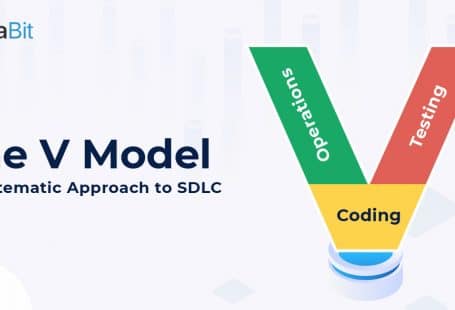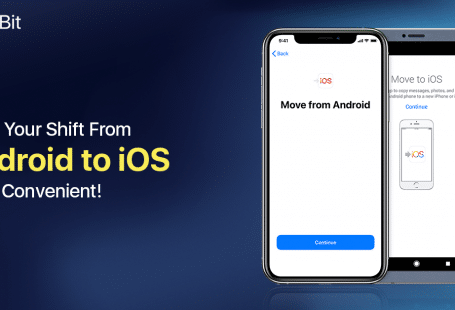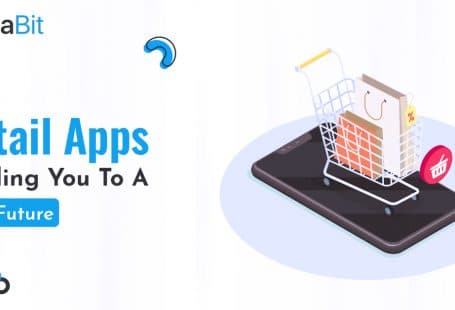You might have heard this many times that if you are not learning from your mistakes, you are not learning at all! It applies to every person seeking improvisation and success in their lives. For business owners, keeping track of their business structure, position, and outcomes becomes essential to gain a competitive edge.
But how can one differentiate oneself from the crowd of marketers striving to become their customers’ favourites? How will business owners prevent themselves from committing a mistake that can damage their business reputation?
Well, there are a plethora of answers to this question, and several tactics can prepare you for the future. However, one of the most preferred and prevalent is predictive analytics of your business. It is a process that uses statistical data to predict the outcomes.
Now, imagine how wonderful it will be if you can transform these data sets into helpful insights for analysing the performance of your digital business. Wouldn’t it be fantastic if you could predict the highs and lows in your mobile app and enhance them to increase its performance and productivity?
Well, this article will discuss the importance of predictive analytics (or modelling) in mobile app development. Along with this, we will also talk about:
- The process of predictive analytics
- Roles of predictive analytics in enhancing the app performance
- Reasons why it is gaining popularity in all the sectors
- The major areas where it can be helpful
What is Predictive Analytics?
Speaking in purely technical terms, predictive analytics or predictive modelling is the process in which one uses mathematical methods and algorithms to predict the possibilities and outcomes of a particular event. However, in simple terms, you can say that it is a process that will assist you in determining what will be advantageous and disadvantageous for you (or your business).
It is like analysing reviews or looking at feedback before buying a product. But the only difference is that these reviews are generally formed from the existing data.
Mainly, predictive analytics is used to analyse the events happening in the future. For example, a diesel engine car company thinking about launching an e-car will first observe the past reports and market requirements before production. It will first look at the loopholes in the already existing cars based on the customer reviews and testing team. If the company’s original products have brought exceptional sales and profits, it can still rely on the same products and look for the areas that require improvements. In that case, there would be no need to go for the experiments.
Although businesses primarily use predictive analytics for futuristic events, you can use it for any occasion, regardless of when it happened. For instance, detectives and forensic experts use predictive analytics to derive the evidence, figure out crimes and identify the suspects after a crime. The prime role of this tool is to detect and estimate the probability of something based on the given data sets. TechTarget has wonderfully described the process of predictive modelling and analytics through a video, and you can have a look at it to better understand this method.
But wait, what is Predictive Analytics in Mobile App Development?
Although this term has been there for decades, it is still new to software development, mobile app development to be specific. Now, since you know how predictive analytics is utilized in everyday activities and business decision making, you might be eager to learn its significance for mobile applications. So, predictive analytics is like a crystal ball that helps you identify everything about your app’s functionalities and suggests actions that can boost its performance. It helps in guesstimating the outcomes based on the analysis of all the activities related to mobile app development. Taking advantage of the potential benefits of predictive analytics can assist mobile app developers in creating apps that are futuristic and show top-quality performance.
What Role Does Predictive Analytics Play in Mobile App Development?
Let’s understand the significance of predictive analytics in mobile app development by answering a question: What makes you feel your app can appear as a winner in the market? Well, it is a hard one. How can someone answer whether something will succeed or not? It’s not always possible to be so sure about something hitting the desired mark. However, you can always predict it, and you will be fully confident about the prediction if your supporting arguments are valid and justified.
Now, back to answering the question asked above. When you analyse all the application areas and identify the fields that require improvements, you can easily fix them. Apart from this, you can run deep market research to understand the market trends and user demands. Moreover, you can also study past reports and prepare a plan accordingly to estimate the success rate of your app. When you mark all these checkpoints, you can be automatically sure about your product and its results.
With a proper predictive analytics plan, you can enhance the app delivery pipeline based on ideal estimates of the time, money and effort needed for the app development. You can also identify the risks involved, the opportunities you can have, eliminate the obstructions and optimise the application performance and functionality. Following this approach, any mobile app development company with hands-on experience in predictive analytics can help businesses develop an app that offers both results and popularity.
Why Is Predictive Analytics Gaining Worldwide Attention in the mobile app development industry?
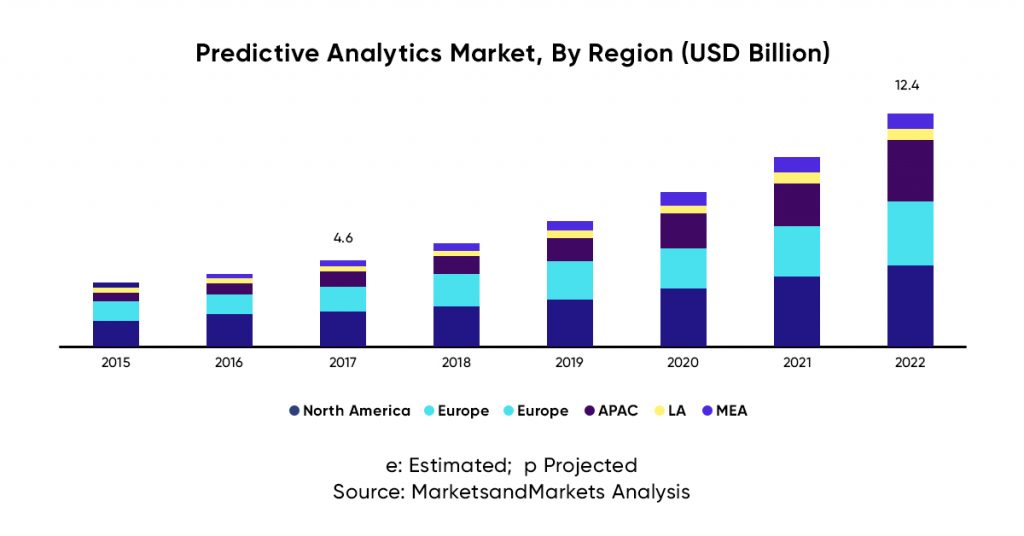
As already mentioned, it is not today that predictive analytics has become so famous, and it has been years since its evolution. According to a report by MarketandMarkets, one can expect the growth of Predictive Analytics from $4.6 billion in 2017 to $12.4 billion by 2022 at a Compound Annual Growth Rate (CAGR) of 22.17% during the forecast period. Businesses have been using it for a long time to improve their productivity and have a competitive advantage in the market. However, its popularity in the mobile app development space is due to specific reasons. Here are some of them:
Bringing the personalised market to the next level
You might have observed the recommendations section while browsing an e-commerce application (Amazon, eBay, etc.), with the title “The things you may like.” It might surprise you how these mobile apps know about your choices or needs. Well, it is the result of predictive analytics in these applications that help them deliver you a more personalised experience based on your search history or purchasing patterns. More are the personalised suggestions in the mobile app, more significant will be the sales and profits. Moreover, it will also assist you in estimating the cost of building an e-commerce app or website based on the features and experience you want to share with your users.
Enhancing user experience
Predictive analytics help you identify the magnetising elements for the users or the areas where user interests turn down to make the modifications accordingly. You can also learn about the user’s device’s specifications and use the information to engineer your app based on it. When you develop an app that meets the users’ expectations and demands, the user experience automatically increases.
Reducing the risks
It is one of the reasons that makes predictive analytics an efficient tool for business owners. With it, you can gather all the necessary data and facts from A to Z to help you monitor your app’s performance and usage trends. You can also identify the risks involved before launching your app through the forecasted reports and make essential changes to get rid of those risks. Apart from these, predictive analytics also predicts fraudulent activities, data breaches, or unusual activities that might harm your brand reputation.
Increasing the user retention
When your application serves top-quality content and delivers an enjoyable experience to the users, they will not even think of uninstalling your app. In fact, the app downloads will increase, increasing the chances of expansion of your customer base.
Predictive analytics helps you see the big picture of the pain points, addressing and fixing, which will make your app more interactive. When the areas that users need to be improved get fixed, they feel considered and hence the brand loyalty increases. Consequently, your app users become potential customers, raising the user retention level.
Types of Predictive Analytics Models
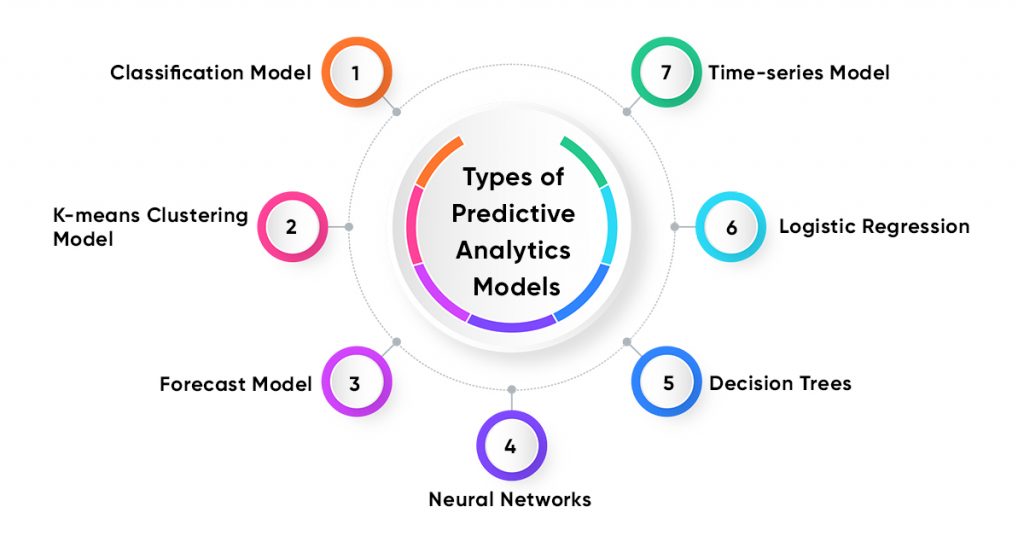
Classification Model
First comes first! Considered one of the simplest models, the classification model collects and organises information to answer direct queries. For example, a classification model can help you answer the “Is this transaction valid?” query.
K-Means Clustering Model
There can be times when you have unlabelled data or data with unspecified characteristics. How would you predict and analyse the data in that case? Well, that’s where the K-means clustering model has significance.
This model binds the data having some common attributes. The primary goal is to group things or people with shared nature or characteristics and plan strategies based on their behaviour in particular situations. For example, predicting the credit risk for a loan applicant can be calculated by analysing what the other person had done in the past under the same circumstances.
Forecast Model
Being one of the most popular predictive models, the Forecast model helps extract information from anything having a numeral value. It works on the data based on learning from past experiences and historical records. For instance, if someone asks you how many calls a customer support agent handles per week, the system can analyse the past records and deliver an estimated value.
Neural Networks
Now, this model has a unique way of working. It is a predictive model that imitates the way a human brain works. People use Neural Networks to deal with complex data relationships using pattern recognition and Artificial Intelligence. One of this model’s most common real-time examples is chess engines. Chess players use a chess engine to analyse their games or predict how an average player could react to particular moves. Since the advent of AI is pretty helpful for the sports industry, you can easily predict the outcomes with your current performance and do the improvisations in the required areas.
Decision Trees
Do you want to know why someone lands into a particular decision? If yes, then decision trees can be an appropriate choice. As the name suggests, this model looks like a tree (resembling an extensive dataset) with many different branches (smaller subsets). When you completely sketch down a decision tree, you will find the branch nodes and leaf nodes. The branch nodes consist of all the choices an individual has, while individual leaves signify a specific decision.
Decision trees are extensively used in the healthcare industry, civil planning, law and order, business decision planning, etc.
Logistic Regression
Logistic regression also follows the classification algorithm to predict the binary outcomes, such as 0/1, True/False, Yes/No, etc. You can use this model specifically when the dependent variable is categorical. With the help of logistic regression, you can easily forecast the probability of an event by putting the data values of prior observations into the logit functions.
For example, Logistic Regression can help predict whether a political candidate will win or lose an election.
Time-Series Model
While Classification and Forecast Models focus on historical records and past experiences, the time series model deals with the data where time is the prime input parameter. It checks for the data points based on time and develops numeric metrics to predict the trend.
A typical example in business can be a sales manager analysing the sales of the last four quarters to predict the expected sales in the next month or even a year.
The 4-Step Process in Predictive Analysis for Mobile App Development
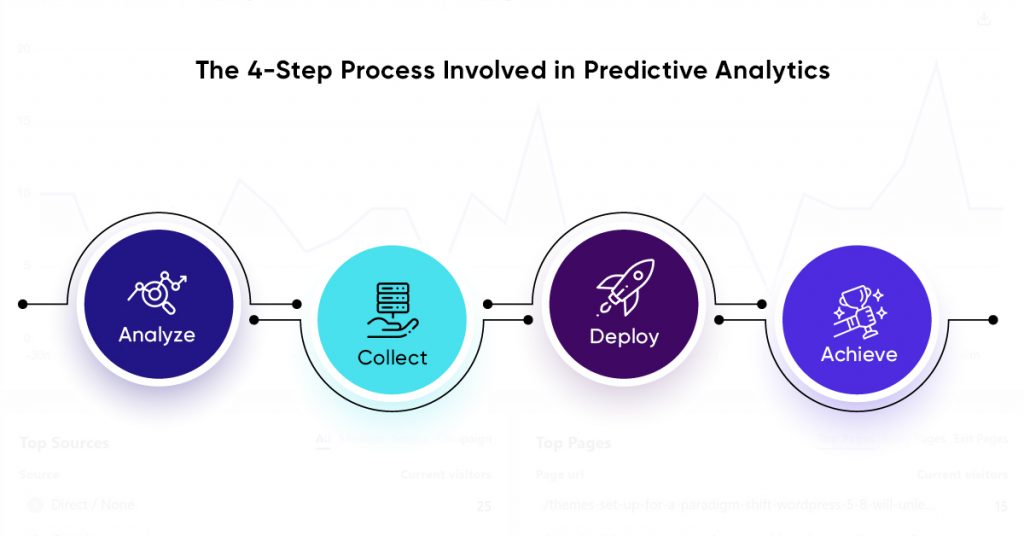
Predictive Analytics is no rocket science, and to get started with it, all you need to do is follow this 4-step easy process.
Analyse:
Before you start doing predictive analysis, it is crucial to prepare a rough objective plan that answers the following questions:
- What is the objective of predicting the future of your mobile app based on records?
- How will you initiate predictive analysis, and what type of data will you need for it?
- What actions will you perform after getting all the information from the process?
Collect:
You need both structured and unstructured data for the process. The raw data needs to be cleaned, and you should give only the required data a green flag for predictive analysis.
Deploy:
In this step, you need to refine your model (whichever you choose for the analysis) that it works based on the data inputs you have. Eventually, you will get the results to analyse.
Achieve:
In the final step, you will need a specialist, say a business analyst, to analyse your data in order to understand and mould the outcomes into business profits.
List of Some Predictive Analytics Tools That Make Predictive Analysis Simple and Easier
A predictive analytics software extracts out existing significant data that assist you in getting critical insights needed for exploring the growth possibilities. You can also identify the potential risks by analysing the trends and best practices suitable for your business. Here are some of the most general predictive analytics tools businesses use worldwide.
Localytics
The first tool in our list is Localytics, a boon for marketers as it enables them to look into the future and predict which users will convert, return, or churn. When there are predictions about the users’ activities and responses beforehand, the developers can stay proactive rather than reactive. Consequently, it will help enhance the user experience, resulting in more user engagement.
Amplitude
Amplitude is an all-rounder that works for both mobile and web applications. It helps keep track of the user’s activity and reaction to the app. With Amplitude, you can learn and analyse the user interactions to prepare user behavioural reports and instantly provide insights to speed up the purchase.
Urbanairship
This predictive analytics tool provides a complete package of reports that indicates all the steps involved in the customer life cycle. The reports include acquisition, enrollment, conversion, activation, retention, and re-engagement of the customers, understanding of which helps drive exponential growth with business success.
SAS advanced analytics
The last and one of the most advanced analytics tools in our list is SAS (Statistical Analytics Software). It offers a range of analytics products and services, such as statistical and text analytics, data mining, optimisation and simulation, forecasting, etc. All these processes help drive information from the raw data required to meet the objectives and purposes.
Top Industries That Implement Predictive Analytics: Application Areas of Predictive Analytics
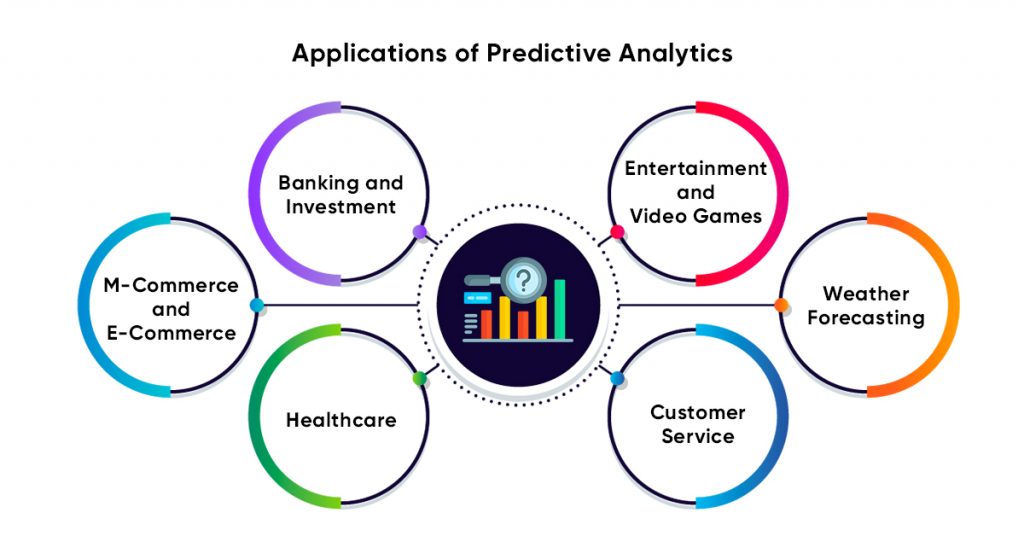
M-commerce Industry
Predictive Analytics has held its grip in most areas, among which M-commerce (or Mobile commerce) tops the list. When you own a business app to enhance yourself digitally, you need to become a fortune-teller so that you can bring genuine delight to your customers. With predictive analytics, you will have more detailed and filtered information about your customers at their disposal. You can leverage your customers’ data to send them customised recommendations and personalise their in-app journey in an all-new automated fashion.
For example, Market leaders such as Amazon analyse their user data, including their search history, past orders, and buying patterns. With predictive analytics, the company tries to understand the interests of its customers and share them with more personalized in-app notifications that might fascinate them. As a result, the customers have a more soothing user experience leading to more interaction and better results.
This way, customers never lose interest in a particular brand. Conclusively, the customer engagement will increase, customer churn will stop, the conversion rate will rise, and the acquisition will process into retention.
Healthcare Industry
The merits of predictive analytics are easily visible in the healthcare sector. A healthcare centre can use the related software to derive a patient’s past medical and health records, ensuring accurate diagnosis and preparing chronic disease management better.
Furthermore, the records of hospitals or healthcare centres can also help enhance the hospital administration, satisfy workforce needs, and reduce wastage of resources. The clinical and financial advantages of predictive analytics can benefit the healthcare industry to implement advanced tools and techniques and bring revolutionary changes in this sector.
Banking and Financial Industry
What is the role of predictive analytics in an industry that deals with banking and finance? This question might arise in your mind too. Now, what if I say that you can answer the customer’s financial queries, understand their demands, detect fraud, and cross-sell the products in ferocious competition, all this with the help of predictive analytics. Wouldn’t it excite you? Well, that’s the truth. With predictive analytics, you can do all of the things mentioned above.
Moreover, the banking, investment and finance industries have already found many use cases of predictive analytics that address the users’ concerns, increase product sales, and raise profits.
Entertainment Industry
The multimedia and entertainment industry is booming rapidly, due to which the players in these areas are also increasing at a faster rate. Companies developing games, audio-visual content and other entertainment-related services are also flourishing. In that case, it becomes critical to win the customers hearts and get an edge over the competitors. For that, a business needs to maintain pace with the customer demands and prevalent market trends. They (companies) need to fill the gap dynamically, and for this, nothing could be better than predictive analytics.
The entertainment giants have occupied the market by hitting the spot on time. For instance, Netflix, the world’s leading subscription-based OTT streaming service, uses predictive analytics to provide the best user experience. The company collects user data based on their watching patterns, wish lists, recently watched movies and series, etc. Netflix analyses the data and derives information based on which it recommends its users as per their preferences. That’s why you might find the “Because you watched this, You might like this…” category on your subscription.
Similarly, music streaming applications, such as Spotify, offer tailored recommendations to their users to groove on their favourite genres. Such services initially ask for users’ interests, like what kind of music they like or which language they prefer. It eliminates the user’s hassle to scroll through millions of songs and land on the type of music they usually choose.
Customer Service and Support
Predictive analytics proves to be helpful in customer service as well. Let’s take an example of clothing or a fabric company. Such companies receive an enormous amount of data on a daily basis. They are bound to store a varied range of user data that exhibits the user’s purchasing details. In order to resolve any concerned user issues, the customer support officers take help from the stored data to analyze and act accordingly.
Weather Forecasting
The application areas of predictive analytics do not limit here. It also plays a significant role in the mobile apps related to climate and temperature. With predictive analytics, the meteorological department analyses the weather patterns that help in precise weather forecasting.
The Future of Predictive Analytics for Mobile Apps
Predictive Analytics forecasts the future of your business and services, and asking about its future would not be appropriate. In the upcoming time, predictive analytics will play a crucial role in the business world, in the same manner it is playing right now.
As per the report by Yahoo! Finance, the global predictive analytics market share is expected to grow from $10.5 billion in 2021 to $28.1 billion at a CAGR of 21.7%. The key factor driving the popularity of this process is its capability to predict user interactions in mobile applications. The ability to forecast the future of a mobile app based on user interest will help minimise app abandonment, reduce the churn rate, and raise the conversion rate. Consequently, better will be the revenue and enhanced will be the company’s growth.

